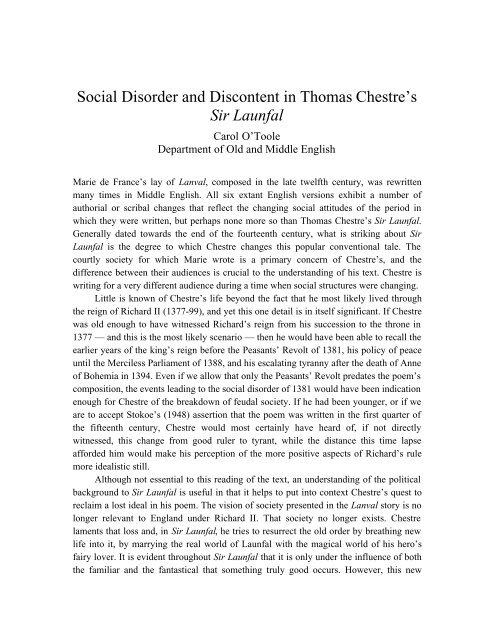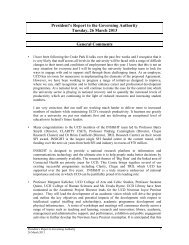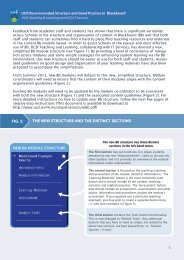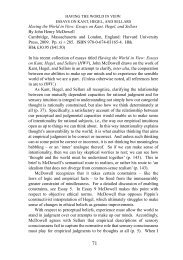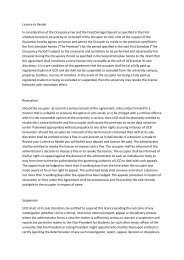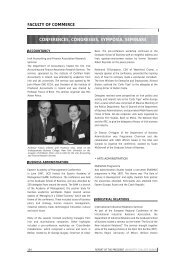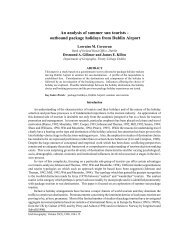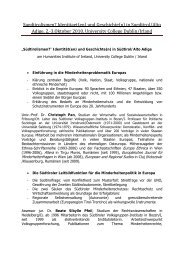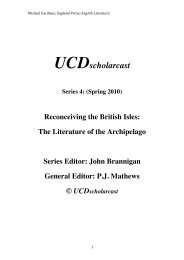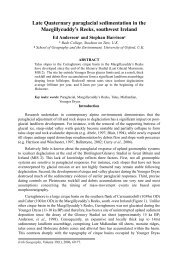Social Disorder and Discontent in Thomas Chestre's Sir Launfal
Social Disorder and Discontent in Thomas Chestre's Sir Launfal
Social Disorder and Discontent in Thomas Chestre's Sir Launfal
You also want an ePaper? Increase the reach of your titles
YUMPU automatically turns print PDFs into web optimized ePapers that Google loves.
<strong>Social</strong> <strong>Disorder</strong> <strong>and</strong> <strong>Discontent</strong> <strong>in</strong> <strong>Thomas</strong> Chestre’s<br />
<strong>Sir</strong> <strong>Launfal</strong><br />
Carol O’Toole<br />
Department of Old <strong>and</strong> Middle English<br />
Marie de France’s lay of Lanval, composed <strong>in</strong> the late twelfth century, was rewritten<br />
many times <strong>in</strong> Middle English. All six extant English versions exhibit a number of<br />
authorial or scribal changes that reflect the chang<strong>in</strong>g social attitudes of the period <strong>in</strong><br />
which they were written, but perhaps none more so than <strong>Thomas</strong> Chestre’s <strong>Sir</strong> <strong>Launfal</strong>.<br />
Generally dated towards the end of the fourteenth century, what is strik<strong>in</strong>g about <strong>Sir</strong><br />
<strong>Launfal</strong> is the degree to which Chestre changes this popular conventional tale. The<br />
courtly society for which Marie wrote is a primary concern of Chestre’s, <strong>and</strong> the<br />
difference between their audiences is crucial to the underst<strong>and</strong><strong>in</strong>g of his text. Chestre is<br />
writ<strong>in</strong>g for a very different audience dur<strong>in</strong>g a time when social structures were chang<strong>in</strong>g.<br />
Little is known of Chestre’s life beyond the fact that he most likely lived through<br />
the reign of Richard II (1377-99), <strong>and</strong> yet this one detail is <strong>in</strong> itself significant. If Chestre<br />
was old enough to have witnessed Richard’s reign from his succession to the throne <strong>in</strong><br />
1377 — <strong>and</strong> this is the most likely scenario — then he would have been able to recall the<br />
earlier years of the k<strong>in</strong>g’s reign before the Peasants’ Revolt of 1381, his policy of peace<br />
until the Merciless Parliament of 1388, <strong>and</strong> his escalat<strong>in</strong>g tyranny after the death of Anne<br />
of Bohemia <strong>in</strong> 1394. Even if we allow that only the Peasants’ Revolt predates the poem’s<br />
composition, the events lead<strong>in</strong>g to the social disorder of 1381 would have been <strong>in</strong>dication<br />
enough for Chestre of the breakdown of feudal society. If he had been younger, or if we<br />
are to accept Stokoe’s (1948) assertion that the poem was written <strong>in</strong> the first quarter of<br />
the fifteenth century, Chestre would most certa<strong>in</strong>ly have heard of, if not directly<br />
witnessed, this change from good ruler to tyrant, while the distance this time lapse<br />
afforded him would make his perception of the more positive aspects of Richard’s rule<br />
more idealistic still.<br />
Although not essential to this read<strong>in</strong>g of the text, an underst<strong>and</strong><strong>in</strong>g of the political<br />
background to <strong>Sir</strong> <strong>Launfal</strong> is useful <strong>in</strong> that it helps to put <strong>in</strong>to context Chestre’s quest to<br />
reclaim a lost ideal <strong>in</strong> his poem. The vision of society presented <strong>in</strong> the Lanval story is no<br />
longer relevant to Engl<strong>and</strong> under Richard II. That society no longer exists. Chestre<br />
laments that loss <strong>and</strong>, <strong>in</strong> <strong>Sir</strong> <strong>Launfal</strong>, he tries to resurrect the old order by breath<strong>in</strong>g new<br />
life <strong>in</strong>to it, by marry<strong>in</strong>g the real world of <strong>Launfal</strong> with the magical world of his hero’s<br />
fairy lover. It is evident throughout <strong>Sir</strong> <strong>Launfal</strong> that it is only under the <strong>in</strong>fluence of both<br />
the familiar <strong>and</strong> the fantastical that someth<strong>in</strong>g truly good occurs. However, this new
partnership is <strong>in</strong>troduced <strong>in</strong> the text as a remedy for an ail<strong>in</strong>g society, a society where the<br />
old order has been corrupted by the adulterous <strong>and</strong> idolatrous phenomenon of courtly<br />
love, a corruption whose self-serv<strong>in</strong>g ideals represent a new world order concerned with<br />
mendacious love <strong>and</strong> material concerns. Chestre is search<strong>in</strong>g for a world of truth,<br />
<strong>in</strong>tegrity <strong>and</strong> honest love, a world that for him existed before the <strong>in</strong>fluence of corruptive<br />
courtly love. <strong>Launfal</strong> represents this ideal world, while the notoriously adulterous<br />
Gu<strong>in</strong>evere personifies the praetorian passions that throw that world <strong>in</strong>to disorder.<br />
There have been few new assessments of <strong>Sir</strong> <strong>Launfal</strong> <strong>in</strong> recent years, <strong>and</strong> many<br />
read<strong>in</strong>gs of Chestre’s text cont<strong>in</strong>ue to centre on the thesis, firmly established <strong>in</strong> the mid<br />
1960s, of <strong>Launfal</strong> as a solitary figure who does not fit <strong>in</strong>. B. K. Mart<strong>in</strong> (1966) sees him as<br />
the typical isolated hero of the folktale, while Daryl Lane (1973) laments his deplorable<br />
treatment at Arthur’s court. <strong>Launfal</strong>’s position <strong>in</strong> society is <strong>in</strong>deed crucial to the<br />
underst<strong>and</strong><strong>in</strong>g of the text, but for different reasons from those that have been previously<br />
proposed. Even a cursory read<strong>in</strong>g of the text should <strong>in</strong>dicate to us that our hero is not <strong>in</strong><br />
fact the mistreated wretch he is often made out to be, <strong>and</strong> that his ‘otherness’ has been<br />
greatly exaggerated. At Arthur’s court <strong>in</strong> Carlisle <strong>Launfal</strong> is made k<strong>in</strong>g’s steward “for his<br />
largesse <strong>and</strong> his bounté” (l<strong>in</strong>e 31). i There is noth<strong>in</strong>g to <strong>in</strong>dicate that he is <strong>in</strong> any way<br />
mistreated or neglected; <strong>in</strong> fact, he holds this position for ten years. There is a marked<br />
difference here <strong>in</strong> comparison with Marie’s lai, where the hero is sorely neglected by the<br />
k<strong>in</strong>g. <strong>Launfal</strong> is very much a part of his community <strong>and</strong> is loved <strong>and</strong> respected.<br />
It is the arrival of Gu<strong>in</strong>evere <strong>and</strong> her neglect of <strong>Launfal</strong> that upsets his utopian<br />
existence. Here Chestre deviates from his primary source, <strong>Sir</strong> L<strong>and</strong>evale, <strong>in</strong> order to<br />
<strong>in</strong>clude the motif of the vengeful queen of ‘Graelent’ <strong>and</strong>, as Peter Lucas (1970) has<br />
po<strong>in</strong>ted out, he places the whole burden of responsibility for the action <strong>in</strong> the tale on<br />
Gu<strong>in</strong>evere’s shoulders. It is she who is the discordant element <strong>in</strong> <strong>Sir</strong> <strong>Launfal</strong>, <strong>and</strong> we can<br />
relate this to a number of Arthurian legends where her affair with Lancelot br<strong>in</strong>gs about<br />
the fall of Camelot. Her arrival marks the beg<strong>in</strong>n<strong>in</strong>g of the decl<strong>in</strong>e <strong>in</strong> <strong>Launfal</strong>’s<br />
relationship with his community, or rather, the decl<strong>in</strong>e of the established status quo, <strong>and</strong><br />
his discomfort with her presence may be seen as an omen of what is to befall his perfect<br />
society. As steward, <strong>Launfal</strong> represents law <strong>and</strong> order, <strong>and</strong> Gu<strong>in</strong>evere’s neglect of him at<br />
the wedd<strong>in</strong>g feast may be seen as her dismissal of the rules <strong>and</strong> structure of the pr<strong>in</strong>ciples<br />
for which he st<strong>and</strong>s. Their mutual dislike of each other is immediate, <strong>and</strong> expressly stated<br />
by Chestre (l<strong>in</strong>es 44, 71). Theirs is a struggle between an established society, a ‘golden<br />
age’ of British history, <strong>and</strong> a new order — or disorder — which threatens that ideal. It is<br />
the newcomer at court, not the established community, who provides the impetus for<br />
<strong>Launfal</strong>’s self-imposed exile.<br />
That his exile is <strong>in</strong>deed self-imposed should not be overlooked. He is not driven<br />
from the court <strong>and</strong> we learn that he will <strong>in</strong> fact be sorely missed by everyone, <strong>in</strong>clud<strong>in</strong>g<br />
the k<strong>in</strong>g. At the news of his imm<strong>in</strong>ent departure Arthur urges him to take “greet<br />
spend<strong>in</strong>g” (l<strong>in</strong>e 81), sends his own nephews as travell<strong>in</strong>g companions, <strong>and</strong> anticipates his
eturn. In Carlisle, <strong>Launfal</strong> is possessed of his own personal identity <strong>and</strong> of true friends<br />
whose loyalty later becomes evident. It has until now been home for him, but with the<br />
com<strong>in</strong>g of Gu<strong>in</strong>evere that changes irrevocably. They cannot both live together <strong>in</strong><br />
Carlisle; only one social order can survive. Although <strong>Launfal</strong> has served his k<strong>in</strong>g<br />
faithfully, Arthur’s marriage to Gu<strong>in</strong>evere represents the ultimate acceptance. The<br />
pernicious Gu<strong>in</strong>evere drives the k<strong>in</strong>g’s steward — order — from court.<br />
In Marie’s lai there is no doubt that, although Lanval is poor, he is still a member<br />
of the rul<strong>in</strong>g classes. There is no Caerleon episode — he simply leaves the court on his<br />
“destrier” (l<strong>in</strong>e 41) ii <strong>and</strong> rides towards his encounter with his lover. In Chestre’s <strong>Sir</strong><br />
<strong>Launfal</strong>, the town of Caerleon serves to embody the new world order which Gu<strong>in</strong>evere<br />
has begun to <strong>in</strong>troduce <strong>in</strong>to Carlisle. In Caerleon, wealth <strong>and</strong> status, not personal<br />
<strong>in</strong>tegrity, def<strong>in</strong>e who <strong>Launfal</strong> is.<br />
Upon his arrival <strong>in</strong> the town <strong>Launfal</strong> reveals that he is no longer one of Arthur’s<br />
knights; Chestre does not allow <strong>Launfal</strong> the <strong>in</strong>dividual to hide beh<strong>in</strong>d <strong>Launfal</strong> the knight.<br />
Once he makes his situation known he is treated with contempt by the mayor, his former<br />
servant. The narrative moves from a society concerned with honour <strong>and</strong> virtue to one<br />
concerned with monetary ga<strong>in</strong>. Anderson, comment<strong>in</strong>g on Kane (1951), Bliss (1960) <strong>and</strong><br />
S<strong>and</strong>s (1966), refers to the “‘bourgeoisification’ of the Lanval story” (Anderson, 1977, p.<br />
116), <strong>and</strong> the mayor’s rise <strong>in</strong> status from servant to head of Caerleon might <strong>in</strong>deed help<br />
to support this argument — if the mayor were a likeable character. Yet Chestre<br />
deliberately creates an <strong>in</strong>dividual who <strong>in</strong>vites our disapproval through his lies, his<br />
concern with social status, <strong>and</strong> his treatment of <strong>Launfal</strong>.<br />
The text does not, as has been previously suggested, represent a sort of wishfulfilment<br />
<strong>in</strong> terms of social advancement <strong>and</strong> monetary ga<strong>in</strong>, but <strong>in</strong> fact deplores the<br />
very pr<strong>in</strong>ciples upon which the community of Caerleon is built. <strong>Launfal</strong>’s drastically<br />
altered circumstances reflect the gap that exists between the ideal society that Arthur’s<br />
court represented <strong>and</strong> the emerg<strong>in</strong>g everyday reality of a world preoccupied with the<br />
atta<strong>in</strong>ment of status <strong>and</strong> wealth. That the mayor, the head <strong>and</strong> representative of the town,<br />
offers <strong>Launfal</strong> his worst room as lodg<strong>in</strong>gs highlights the disregard that this new social<br />
order has for the old world. While <strong>Launfal</strong> may reside <strong>in</strong> Caerlon, it is not home for him.<br />
Its values are not his values.<br />
We very quickly come to expect dishonesty <strong>and</strong> treachery from the Machiavellian<br />
mayor, but we do not expect it from the noble <strong>Launfal</strong>; as a result the two lies that<br />
<strong>Launfal</strong> tells <strong>in</strong> the course of the tale are highly significant. When he urges John <strong>and</strong><br />
Hugh not to reveal his misfortune to Arthur he underl<strong>in</strong>es what his <strong>in</strong>itial lie about his<br />
father’s funeral first <strong>in</strong>dicated — that he is genu<strong>in</strong>ely concerned with the court’s op<strong>in</strong>ion.<br />
Whereas he hides noth<strong>in</strong>g from the townsfolk of Caerleon, he takes great pa<strong>in</strong>s to<br />
ma<strong>in</strong>ta<strong>in</strong> some semblance of personal prestige <strong>in</strong> the eyes of Arthur <strong>and</strong> his court. His<br />
concern is reciprocated <strong>in</strong> Arthur’s delight <strong>in</strong> hear<strong>in</strong>g that he is “<strong>in</strong> good lik<strong>in</strong>g” (l<strong>in</strong>e<br />
176). Aga<strong>in</strong>, it is only Gu<strong>in</strong>evere — the newcomer — who is disgruntled by this news.
Presumably <strong>Launfal</strong> hopes that one day he will rejo<strong>in</strong> the community of Carlisle, but, if it<br />
is such an <strong>in</strong>clusive <strong>and</strong> accept<strong>in</strong>g community, why should he be so concerned with the<br />
court’s op<strong>in</strong>ion of him? He worries because that community has changed. Its lady is a<br />
tramp, the furthest th<strong>in</strong>g from honour <strong>and</strong> virtue possible. Like Caerleon, her values are<br />
not his values, <strong>and</strong> the text prompts us to consider whether at this stage <strong>Launfal</strong> actually<br />
has a home to return to. The mayor <strong>and</strong> Gu<strong>in</strong>evere, representatives of this new order,<br />
underm<strong>in</strong>e <strong>Launfal</strong>’s place <strong>in</strong> society by underm<strong>in</strong><strong>in</strong>g the values upon which his ideal<br />
society was based.<br />
In Caerleon, his isolation cont<strong>in</strong>ues. Ostracised by those of rank, <strong>Launfal</strong> is not<br />
<strong>in</strong>vited to their feast “for his poverté” (l<strong>in</strong>e 187). Yet his exclusion from the festivities<br />
marks a turn<strong>in</strong>g po<strong>in</strong>t <strong>in</strong> <strong>Launfal</strong>’s fortunes. In the absence of the members of this<br />
mercantile society, the k<strong>in</strong>dness of the mayor’s daughter, who <strong>in</strong>vites him to d<strong>in</strong>e with<br />
her, becomes the precursor to his return to society. Her k<strong>in</strong>dness represents the last<br />
vestige of the old order <strong>in</strong> Caerleon, <strong>and</strong> her role as the traditional wayside damsel who<br />
aids the hero harks back to the traditional perception of an ideal society that Carlisle<br />
represented before the arrival of Gu<strong>in</strong>evere. That he decl<strong>in</strong>es is not as important as the<br />
fact that she has asked, <strong>and</strong>, <strong>in</strong> loan<strong>in</strong>g him a saddle <strong>and</strong> bridle, she precipitates his<br />
meet<strong>in</strong>g with Triamour.<br />
The <strong>in</strong>troduction of the fairy world of Dame Triamour <strong>in</strong> <strong>Sir</strong> <strong>Launfal</strong> is, as Boitani<br />
has observed, “gradual, gentle <strong>and</strong> rhythmic” (Boitani, 1982, p. 56). The slow, dignified<br />
approach of the “gentil maidenes two” (l<strong>in</strong>e 231) is heightened by its contrast to the<br />
immediately preced<strong>in</strong>g account of the jeer<strong>in</strong>g men who mock <strong>Launfal</strong> as his horse slips<br />
<strong>in</strong> the mud. The maidens’ courteous words <strong>and</strong> manner <strong>and</strong> the oriental richness of the<br />
pavilion to which they br<strong>in</strong>g him provide a counterpo<strong>in</strong>t to the mud <strong>and</strong> mockery of<br />
Caerleon.<br />
Yet despite this ceremonial <strong>in</strong>troduction, Chestre’s treatment of the supernatural<br />
elements of the story is far more matter-of-fact than <strong>in</strong> Marie’s Lanval. For a start, the<br />
borderl<strong>in</strong>e between the world of Lanval <strong>and</strong> his fairy lover is very def<strong>in</strong>ite <strong>in</strong> the French<br />
lai: Marie uses a river as the boundary l<strong>in</strong>e that separates the two realms, water be<strong>in</strong>g a<br />
common divide between the real <strong>and</strong> the magical. There is no such boundary <strong>in</strong> Chestre’s<br />
tale for <strong>Launfal</strong> to cross, <strong>and</strong> even the fear that Lanval’s horse displays <strong>in</strong> Marie’s lai<br />
before the knight’s encounter with his mistress is absent. Estranged from Carlisle as a<br />
result of Gu<strong>in</strong>evere’s malevolence, <strong>and</strong> from Caerleon as a result of his poverty, <strong>Launfal</strong><br />
is no longer at home <strong>in</strong> his own world. He already exists <strong>in</strong> a twilight world somewhere<br />
outside society.<br />
Chestre makes some other significant changes perta<strong>in</strong><strong>in</strong>g to the magical elements of<br />
the tale. While we sense that Marie’s fairy is not of this world, details are avoided,<br />
add<strong>in</strong>g to the mystery. There is no concrete description of her, she is not named <strong>and</strong> we<br />
are not told where she is from. The story is related, <strong>in</strong> Stemmler’s words, “mit dem<br />
Schauder des Ungewissen” (Stemmler, 1962, p. 250), with a quiver of the uncerta<strong>in</strong>. This
atmosphere vanishes <strong>in</strong> Chestre’s version. The supernatural is presented <strong>in</strong> concrete<br />
terms <strong>and</strong> with matter-of-fact realism. The divid<strong>in</strong>g l<strong>in</strong>e between <strong>Launfal</strong>’s world <strong>and</strong><br />
that of his fairy lover is removed, <strong>and</strong> they <strong>in</strong>teract as two ord<strong>in</strong>ary lovers might.<br />
Triamour is named by her ladies-<strong>in</strong>-wait<strong>in</strong>g before we even meet her, <strong>and</strong> Chestre<br />
expressly states that she is the daughter of the “K<strong>in</strong>g of Fairie”:<br />
The k<strong>in</strong>ges doughter of Olyroun<br />
Dame Triamoure that highte.<br />
Here fadir was K<strong>in</strong>g of Fairie<br />
Of Occient, fere <strong>and</strong> nyie [...] (l<strong>in</strong>es 278-81)<br />
In fact, where Marie understates everyth<strong>in</strong>g, leav<strong>in</strong>g us to imag<strong>in</strong>e the orig<strong>in</strong>s of her<br />
“pucele” (l<strong>in</strong>e 108), Chestre does the opposite, add<strong>in</strong>g extra magical details (such as<br />
<strong>Launfal</strong>’s magic purse) to the extent that the impact that Marie’s veil of mystery had on<br />
the reader is lost. Chestre moves from focus<strong>in</strong>g on the ethereal essence of the situation to<br />
describ<strong>in</strong>g physical details: the <strong>in</strong>tr<strong>in</strong>sic beauty of Triamour <strong>and</strong> her ladies-<strong>in</strong>-wait<strong>in</strong>g is<br />
ignored <strong>in</strong> favour of detailed descriptions of her cloth<strong>in</strong>g <strong>and</strong> surround<strong>in</strong>gs.<br />
Ménard remarks on the “mélange <strong>in</strong>dissociable du merveilleux et du réel” (Ménard,<br />
1979, p. 181) <strong>in</strong> Marie’s lais. The two are separate but necessarily <strong>in</strong>tertw<strong>in</strong>ed: “Les lais<br />
de Marie de France ne se déroulent pas dans un pays surnaturel ou dans un monde<br />
enchanté. Ils se passent en ple<strong>in</strong> sur la terre des hommes ... [mais] le merveilleux est<br />
toujours mystérieux” (Ménard, 1979, p. 168). In Chestre’s poem, this element of mystery<br />
is lost — one is as common as the other, <strong>and</strong> both are treated as a conventional reality.<br />
While he expressly states that Triamour is a fairy, this revelation has little impact both on<br />
the audience <strong>and</strong> on <strong>Launfal</strong> himself, <strong>and</strong> her magical qualities are taken for granted.<br />
This shift <strong>in</strong> emphasis is essential to the underst<strong>and</strong><strong>in</strong>g of the tale. The magical elements<br />
<strong>in</strong> <strong>Sir</strong> <strong>Launfal</strong> are downplayed <strong>in</strong> order to highlight the honesty, openness <strong>and</strong> <strong>in</strong>tegrity of<br />
Triamour. Yes, she is a fairy, but this is not where her real magic lies: for <strong>Launfal</strong> she is<br />
literally a wish come true, s<strong>in</strong>ce she represents everyth<strong>in</strong>g he mourns for <strong>in</strong> his own<br />
world.<br />
The relationship between Lanval <strong>and</strong> his mistress <strong>in</strong> the French lai follows the<br />
courtly tradition: the fairy lover asks that Lanval be “pruz e curteis” (l<strong>in</strong>e 113), <strong>and</strong> he <strong>in</strong><br />
turn is immediately struck by the love-bolt that afflicts all courtly lovers. In Chestre’s<br />
text, however, Triamour’s seduction of <strong>Launfal</strong> runs contrary to the conventions of the<br />
courtly romance, s<strong>in</strong>ce she <strong>in</strong>itiates the relationship <strong>in</strong> a far more open <strong>and</strong> honest<br />
manner than we have become used to elsewhere. And yet, <strong>in</strong> spite of her forwardness,<br />
she is described <strong>in</strong> virg<strong>in</strong>al terms:<br />
She was as whit as lilie <strong>in</strong> May<br />
Or snow that sneweth <strong>in</strong> w<strong>in</strong>teris day [...] (l<strong>in</strong>es 301-2)
Triamour, <strong>in</strong> fact, is the absolute antithesis of the promiscuous Gu<strong>in</strong>evere. Her nakedness<br />
is the physical manifestation of her openness <strong>and</strong> honesty. This openness, <strong>in</strong> contrast to<br />
courtly <strong>and</strong> Ovidian rules, highlights what can be viewed as the superficial nature of the<br />
courtly worship of the beloved, a devotion which, <strong>in</strong> the history of Camelot, is<br />
detrimental to that utopia. As Gu<strong>in</strong>evere (here, corruptive courtly love) brought about<br />
<strong>Launfal</strong>’s departure from court, so Triamour (honest love) facilitates his return.<br />
For Chestre, the one aspect of chivalric society that he cannot reconcile with his<br />
ideal vision is courtly love. He views it as a destructive force, the growth of which<br />
ultimately led to the decl<strong>in</strong>e of the old order which he values so highly. While its<br />
<strong>in</strong>tentions may seem honourable, <strong>in</strong> practice it is entirely contrived, thriv<strong>in</strong>g on<br />
deception, self-pity <strong>and</strong>, <strong>in</strong> more than one <strong>in</strong>stance, adultery. <strong>Sir</strong> <strong>Launfal</strong>, <strong>in</strong> fact, is closer<br />
<strong>in</strong> sentiment to Gower’s Confessio Amantis than Ovid’s Ars Amatoria. <strong>Launfal</strong> <strong>and</strong><br />
Triamour’s banquet <strong>in</strong> the pavilion — private, <strong>in</strong>timate <strong>and</strong> relaxed — both recalls <strong>and</strong><br />
contrasts with Arthur <strong>and</strong> Gu<strong>in</strong>evere’s wedd<strong>in</strong>g feast, <strong>and</strong> emphasises the difference<br />
between superficial courtly love, where the beloved is placed on a pedestal, <strong>and</strong> true<br />
love, of which Marie herself would most certa<strong>in</strong>ly have approved. In return for his love<br />
Triamour offers <strong>Launfal</strong> riches <strong>and</strong> devotion. Gu<strong>in</strong>evere, the selfish <strong>and</strong> adulterous<br />
representative of courtly love, later dem<strong>and</strong>s his love, offer<strong>in</strong>g noth<strong>in</strong>g but v<strong>in</strong>dictive lies<br />
<strong>in</strong> return when he refuses her advances.<br />
Support<strong>in</strong>g this <strong>in</strong>terpretation of Gu<strong>in</strong>evere as the representative of destructive <strong>and</strong><br />
dishonest courtly love is one highly significant element of Triamour <strong>and</strong> <strong>Launfal</strong>’s<br />
relationship upon which Chestre <strong>and</strong> Marie agree. Unlike the relationships <strong>in</strong> many of<br />
Marie’s other lais — Milun, Yonec <strong>and</strong> Le Fresne, for example — Lanval’s relationship<br />
with his fairy lover is not adulterous, thus subvert<strong>in</strong>g the love theme established by such<br />
couples as Diarmuid <strong>and</strong> Gr·<strong>in</strong>ne, Tristan <strong>and</strong> Iseult, <strong>and</strong>, of course, Gu<strong>in</strong>evere <strong>and</strong><br />
Lancelot. This works particularly well <strong>in</strong> the thematic context of Chestre’s version, s<strong>in</strong>ce<br />
adultery is one of the primary th<strong>in</strong>gs that Gu<strong>in</strong>evere is renowned for, highlight<strong>in</strong>g the<br />
essential purity of the relationship between the knight <strong>and</strong> his fairy lover.<br />
Triamour’s world, however, is not <strong>Launfal</strong>’s true home. He does not belong to the<br />
fairy world, <strong>and</strong> so returns to Caerleon where his fortunes are restored. Another key<br />
<strong>in</strong>dication of the lack of division between the two worlds lies <strong>in</strong> the reaction of the hero<br />
to his change of fortune. Lanval, <strong>in</strong> Marie’s version, returns <strong>in</strong> a state of shock (l<strong>in</strong>es.<br />
196-200), a shock that is also t<strong>in</strong>ged with a not <strong>in</strong>considerable sense of fear, yet Chestre’s<br />
<strong>Launfal</strong> takes to his new circumstances like the proverbial duck to water. It is fitt<strong>in</strong>g that<br />
the tournament <strong>in</strong> his honour should be held <strong>in</strong> Caerleon among the fickle townspeople<br />
who previously mocked him. The hypocrisy of the mayor, <strong>and</strong> <strong>Launfal</strong>’s reply, rem<strong>in</strong>d us<br />
that their newly found concern is not for <strong>Launfal</strong> the person but for <strong>Launfal</strong> the wealthy<br />
knight. His return to his old home of Carlisle does not occur until after his defeat of<br />
Valentyne, when Arthur sends for him. It is also significant that Arthur hears of his<br />
success across the sea <strong>in</strong> Lombardy, not <strong>in</strong> Caerleon. Although geographically nearer,
Carlisle <strong>and</strong> Caerleon are worlds apart. Nevertheless, <strong>in</strong> the light of <strong>Launfal</strong>’s recent<br />
adventures we must ask ourselves: for how much longer?<br />
Unlike the Caerleon tournament, ostensibly held <strong>in</strong> his honour, Arthur’s feast is a<br />
community affair of which <strong>Launfal</strong> is a part. While this second feast may not be <strong>in</strong> his<br />
honour, it must surely be the more important of the two for <strong>Launfal</strong> s<strong>in</strong>ce it sees his<br />
re<strong>in</strong>statement as k<strong>in</strong>g’s steward (l<strong>in</strong>e 622), before Gu<strong>in</strong>evere yet aga<strong>in</strong> upsets the balance.<br />
Her sudden <strong>in</strong>terest <strong>in</strong> <strong>Launfal</strong> highlights her fickleness <strong>and</strong> re<strong>in</strong>forces her reputation as<br />
an adulteress. While Marie presents only a short dance scene as a prelude to the queen’s<br />
proposition<strong>in</strong>g of Lanval, Chestre’s description is lengthier, <strong>and</strong> Gu<strong>in</strong>evere’s long drawnout<br />
danc<strong>in</strong>g contrasts with the forward honesty of Triamour. Her sudden turnabout,<br />
together with her claim that she has loved <strong>Launfal</strong> passionately for the past seven years,<br />
exposes her self-delud<strong>in</strong>g selfishness:<br />
I have the lovid with all my might<br />
More than this seven yere [...] (l<strong>in</strong>es 677-8)<br />
The extent to which Gu<strong>in</strong>evere is portrayed as a malignant, destructive force is<br />
emphasised by her effect on <strong>Launfal</strong> himself. While his reply may be justified <strong>in</strong> the light<br />
of Gu<strong>in</strong>evere’s reputation, it is hardly the behaviour befitt<strong>in</strong>g a knight towards his queen,<br />
the wife of his feudal lord. The polar opposites which Gu<strong>in</strong>evere <strong>and</strong> Triamour represent<br />
are also highlighted <strong>in</strong> the queen’s behaviour: whereas Triamour gave all <strong>and</strong> asked only<br />
for loyalty <strong>in</strong> return, Gu<strong>in</strong>evere, to satisfy her greedy desires, dem<strong>and</strong>s that <strong>Launfal</strong> be<br />
disloyal to his k<strong>in</strong>g, her husb<strong>and</strong>. Gu<strong>in</strong>evere aga<strong>in</strong> proves his undo<strong>in</strong>g as her taunts cause<br />
him to retaliate, break<strong>in</strong>g his vow to Triamour. His magical gifts are withdrawn <strong>and</strong> he is<br />
bound <strong>and</strong> brought before the k<strong>in</strong>g to face charges of treason.<br />
Yet even at this dire time <strong>Launfal</strong> is not alone. Like Hugh <strong>and</strong> John before, he has<br />
true friends who st<strong>and</strong> by him through the trial. Unlike the people of Caerleon, his<br />
change of fortune does not affect their op<strong>in</strong>ion of him. Arthur’s court is, <strong>in</strong> Earl<br />
Anderson’s words, part of “an <strong>in</strong>ternal audience that responds to <strong>Launfal</strong>’s chang<strong>in</strong>g<br />
fortunes” (Anderson, 1977, p. 123), <strong>and</strong> they assess the situation on the basis of the man<br />
they know him to be, not on the wealth he does or does not possess. Equally, the twelve<br />
knights assigned to the task of exam<strong>in</strong><strong>in</strong>g the case are not afraid to take <strong>in</strong>to account<br />
Gu<strong>in</strong>evere’s reputation for promiscuity — someth<strong>in</strong>g which is acknowledged even before<br />
Triamour arrives to confirm it. They decide that it is she who is at fault, <strong>and</strong> are ready to<br />
acquit <strong>Launfal</strong> on the condition that he produce his lover, or one of her maids. He is<br />
given a perfectly reasonable time-frame — a year <strong>and</strong> a fortnight — <strong>in</strong> which to fulfil<br />
this condition, <strong>and</strong> when he admits at the end of this period that he cannot satisfy the<br />
requirement the Earl of Cornwall steps <strong>in</strong> to plead that the penalty be reduced from<br />
hang<strong>in</strong>g to exile.<br />
Lest we th<strong>in</strong>k that this show of solidarity looks promis<strong>in</strong>g, however, it must be<br />
recognised that it is Arthur — the k<strong>in</strong>g <strong>and</strong> therefore the person who represents his court
— who is the one person who reacts negatively towards <strong>Launfal</strong> follow<strong>in</strong>g Gu<strong>in</strong>evere’s<br />
accusations. The extent of her <strong>in</strong>fluence on her husb<strong>and</strong> is evident, s<strong>in</strong>ce he has clearly<br />
forgotten the faithful service of his steward <strong>in</strong> the past. Arthur has become more like the<br />
ungrateful mayor of Caerleon who failed to remember <strong>Launfal</strong>’s largesse. The attitude of<br />
the head of the court is dangerously close to that of the head of the town of Caerleon.<br />
Arthur’s marriage to Gu<strong>in</strong>evere weds the old order with the destructive force of courtly<br />
love, result<strong>in</strong>g <strong>in</strong> the birth of a new, self-serv<strong>in</strong>g vision of society. As k<strong>in</strong>g, Arthur’s<br />
concern is not for justice but for the gratification of the dem<strong>and</strong>s of this new world order.<br />
By contrast, Triamour comes to <strong>Launfal</strong>’s aid despite his broken vow, emphasis<strong>in</strong>g the<br />
essential selflessness, compassion <strong>and</strong> forgiveness of honest love. She becomes his<br />
v<strong>in</strong>dicator where Gu<strong>in</strong>evere is his victimiser.<br />
Chestre’s description of Triamour’s arrival at Arthur’s court has attracted much<br />
criticism for his focus<strong>in</strong>g on the materialistic elements of his narrative. Marie describes<br />
her hero’s lover <strong>in</strong> general terms; her beauty is emphasised, but not detailed. Here, also,<br />
is the only time we receive any <strong>in</strong>dication from Marie of her orig<strong>in</strong>s, <strong>and</strong> yet even still it<br />
is not explicitly stated that she is a fairy: we are simply told that she takes Lanval with<br />
her to Avalon, <strong>and</strong> the rest is left for us to surmise. Chestre gives precious little more<br />
detail of Triamour than Marie — the focus of his exp<strong>and</strong>ed description is on her crown,<br />
her f<strong>in</strong>e clothes, her horse’s bridle, the collars of her hounds. What is significant here,<br />
though, is that her arrival, <strong>and</strong> that of her ladies-<strong>in</strong>-wait<strong>in</strong>g, is seen through the eyes of<br />
the knights. It is they who focus on these materialistic elements, an <strong>in</strong>dication that while<br />
the knights may show <strong>Launfal</strong> their support, their values have altered. It is only <strong>Launfal</strong><br />
who sees Triamour for who she is. He pays no heed to the trapp<strong>in</strong>gs of the procession,<br />
simply to his lover:<br />
And whan <strong>Launfal</strong> sawe that lady,<br />
To alle the folk he gan crie an hy,<br />
Bothe to yonge <strong>and</strong> olde,<br />
“Here,” he seide, “comith my laman swete!” (l<strong>in</strong>es 967-70)<br />
Triamour’s punishment of Gu<strong>in</strong>evere is unique to Chestre’s version of the tale: she<br />
breathes on Gu<strong>in</strong>evere, bl<strong>in</strong>d<strong>in</strong>g the queen <strong>in</strong> accordance with her earlier oath. The<br />
punishment is fitt<strong>in</strong>g <strong>in</strong> the context of this read<strong>in</strong>g of the text: Gu<strong>in</strong>evere is bl<strong>in</strong>ded<br />
because the vision of society that she represents is dangerously flawed. The <strong>in</strong>fluence of<br />
her presence at court has bl<strong>in</strong>ded her husb<strong>and</strong> to the true value of his loyal steward.<br />
<strong>Launfal</strong>’s situation is a direct result of her decision to approach him after see<strong>in</strong>g him<br />
danc<strong>in</strong>g from her tower, <strong>and</strong> yet the usual relationship between look<strong>in</strong>g <strong>and</strong> lov<strong>in</strong>g that<br />
we f<strong>in</strong>d elsewhere <strong>in</strong> courtly romances is corrupted: the object of Gu<strong>in</strong>evere’s affection is<br />
never <strong>Launfal</strong>, it is herself. She is so sure of her own beauty that she is will<strong>in</strong>g to wager<br />
her eyes that <strong>Launfal</strong> cannot produce someone fairer than she is, <strong>and</strong> moves as a result<br />
from be<strong>in</strong>g bl<strong>in</strong>ded by her own selfish narcissism to literal bl<strong>in</strong>dness.
<strong>Sir</strong> <strong>Launfal</strong> represents a hanker<strong>in</strong>g after a past ideal dur<strong>in</strong>g a time when bourgeois<br />
priorities centred on the accumulation of wealth. It offers an alternative, more positive<br />
option where the real <strong>and</strong> the other might co-exist, where the world represented by the<br />
Arthurian ‘golden age’ might be balanced with the openness, honesty <strong>and</strong> <strong>in</strong>tegrity that<br />
Triamour embodies. It is a new vision of society, a compromise between a lost past<br />
before the advent of dishonest <strong>and</strong> destructive courtly love, <strong>and</strong> a hoped-for future. The<br />
lack of a happy medium <strong>in</strong> the real world of <strong>Sir</strong> <strong>Launfal</strong>, however, is an<br />
acknowledgement on Chestre’s part that this dream is, for the moment at least,<br />
unatta<strong>in</strong>able. In Richard II’s reign, perhaps, he sees a society where largesse has been<br />
replaced by heavy poll taxes, where a ruler’s early idea of k<strong>in</strong>gship is corrupted by the<br />
self-serv<strong>in</strong>g greed of his subjects, <strong>and</strong> where the death of his wife, arguably the<br />
stabilis<strong>in</strong>g force <strong>in</strong> Richard’s life, results <strong>in</strong> the loss of his ability to rule justly.<br />
<strong>Launfal</strong> chooses to leave Carlisle to live with Triamour <strong>in</strong> Oliroun. For him, home<br />
is literally where the heart is. Although he is now out of danger <strong>and</strong> Gu<strong>in</strong>evere has been<br />
punished, she is still alive, <strong>and</strong> Carlisle will never be home for him as long as it is<br />
susceptible to her discordant <strong>in</strong>fluence. It is a past that he cannot reclaim <strong>and</strong> he must<br />
seek solace elsewhere. He will never f<strong>in</strong>d the real honour, genu<strong>in</strong>e chivalry, <strong>and</strong> true <strong>and</strong><br />
honest love that he seeks <strong>in</strong> the real world <strong>and</strong> so, reunited with his mistress, he is “take<br />
<strong>in</strong> to fairie” (l<strong>in</strong>e 1035). As a human liv<strong>in</strong>g <strong>in</strong> the fairy world, however, <strong>Launfal</strong> will<br />
always be a stranger; once a year he returns to the real world to snatch a taste of real life.<br />
It is tempt<strong>in</strong>g to believe that he returns to check up on th<strong>in</strong>gs, to assess whether the old<br />
order might be restored, <strong>and</strong> yet the severance between the two worlds is explicit <strong>and</strong><br />
f<strong>in</strong>al only at the end of the text. <strong>Launfal</strong> may return to joust — the old knight contest<strong>in</strong>g<br />
the new — but his return visits are never homecom<strong>in</strong>gs. We f<strong>in</strong>d <strong>in</strong> this f<strong>in</strong>al severance<br />
an acceptance that there is no go<strong>in</strong>g back. <strong>Launfal</strong> — <strong>and</strong> Chestre — must accept that<br />
this paradise lost cannot be rega<strong>in</strong>ed. Society, <strong>and</strong> its values, have changed.<br />
BIBLIOGRAPHY<br />
PRIMARY SOURCES<br />
Bliss, A. J. (ed.) (1960), <strong>Thomas</strong> Chestre: <strong>Sir</strong> <strong>Launfal</strong>, London <strong>and</strong> Ed<strong>in</strong>burgh, <strong>Thomas</strong><br />
Nelson & Sons.<br />
Rychner, J. (1958), Le lai de Lanval, Paris, Librairie M<strong>in</strong>ard.<br />
SECONDARY SOURCES<br />
Anderson, E. R. (1977), ‘The Structure of <strong>Sir</strong> <strong>Launfal</strong>’, Papers on Language <strong>and</strong><br />
Literature, 13, 115-24.
Boitani, P. (1982), English Narrative <strong>in</strong> the Thirteenth <strong>and</strong> Fourteenth Centuries,<br />
translated by J. K. Hall, Cambridge, Cambridge University Press.<br />
Kane, G. (1951), Middle English Literature: a Critical Study of the Romances, the<br />
Religious Lyrics, Piers Plowman, London, Methuen.<br />
Lane, D. (1973), ‘Conflict <strong>in</strong> <strong>Sir</strong> <strong>Launfal</strong>’, Neuphilologische Mitteilungen, 74, 283-7.<br />
Lucas, P. J. (1970), ‘Towards an Interpretation of <strong>Sir</strong> <strong>Launfal</strong>, with Particular Reference<br />
to L<strong>in</strong>e 683’, Medium Δvum, 39, 291-300.<br />
Mart<strong>in</strong>, B. K. (1966), ‘<strong>Sir</strong> <strong>Launfal</strong> <strong>and</strong> the Folktale’, Medium Δvum, 35, 199-210.<br />
Ménard, P. (1979), Les lais de Marie de France: contes d’amour et d’aventure du moyen<br />
âge, Paris, Presses Universitaires de France.<br />
S<strong>and</strong>s, D. B. (ed.) (1966), Middle English Verse Romances, New York, Holt, R<strong>in</strong>ehart &<br />
W<strong>in</strong>ston.<br />
Stemmler, T. (1962), ‘Die Mittelenglischen Bearbeitungen zweier Lais der Marie de<br />
France’, Anglia, 80, 243-63.<br />
Stokoe, Jr, W. C. (1948), ‘The sources of <strong>Sir</strong> <strong>Launfal</strong>: Lanval <strong>and</strong> Graelent’, PMLA, 63,<br />
392-404.<br />
i<br />
ii<br />
Bliss, 1960. All quotations from <strong>Sir</strong> <strong>Launfal</strong> are from this edition.<br />
Rychner, 1958. All quotations from Lanval are from this edition.


